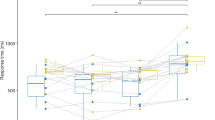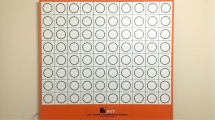Abstract
Participants with normal (StereoN) and weak (StereoW) stereopsis caught tennis balls under monocular and binocular viewing at three different speed conditions. Monocular or binocular viewing did not affect catching performance in catchers with weak stereopsis, while the StereoN group caught more balls under binocular vision as compared with the monocular condition. These effects were more pronounced with increasing ball speed. Kinematic analysis of the catch partially corroborated these findings. These results indicate that StereoW catchers have not developed a compensatory strategy for information pick-up, and that negative effects of a lack of stereopsis grow larger as temporal constraints become more severe. These findings also support the notion that several monocular and/or binocular information sources can be used in the control of interceptive action.

Similar content being viewed by others
References
Alderson GJK, Sully DJ, Sully HG (1974) An operational analysis of a one-handed catching task using high speed photography. J Mot Behav 6:217–226
Bennett SJ, Davids K, Craig T (1999a) The effect of temporal and informational constraints on one-handed catching performance. Res Q Exerc Sport 70:206–211
Bennett SJ, van der Kamp J, Savelsbergh GJP, Davids K (1999b) Timing a one-handed catch. I. Effects of telestereoscopic viewing. Exp Brain Res 129:362–368
Bennett SJ, van der Kamp J, Savelsbergh GJP, Davids K (2000) Discriminating the role of binocular information in the timing of a one-handed catch. The effects of telestereoscopic viewing and ball size. Exp Brain Res 135:341–347
Bootsma RJ, Houbiers MHJ, Whiting HTA, van Wieringen PCW (1991) Acquiring an attacking fore-hand drive: the effects of static and dynamic environmental conditions. Res Q Exerc Sport 62:276–284
Collewijn H, Erkelens CJ (1990) Binocular eye movements and the perception of depth. In: Kowler E (ed) Eye movements and their role in visual and cognitive processes. Elsevier Science, Amsterdam, pp 213–261
Cynader M, Regan D (1978) Neurons in cat para-striate cortex sensitive to the direction of motion in three-dimensional space. J Physiol 274:549–569
Davson H (1990) Visual perception: introduction. In: Davson H (ed) Physiology of the eye. MacMillan, London, pp 449–485
Fielder AR, Moseley MJ (1996) Does stereopsis matter in humans? Eye 10:233–238
Gray R, Regan D (1998) Accuracy of estimating time to collision using binocular and monocular information. Vision Res 38:499–512
Heuer H (1993) Estimates of time to contact based on changing size and changing target vergence. Perception 22:549–563
Jones RK, Lee DN (1981) Why two eyes are better than one: the two views of binocular vision. J Exp Psychol Hum Percept Perform 7:30–40
Judge SJ, Bradford CM (1988) Adaptation to telestereoscopic viewing measured by one-handed ball-catching performance. Perception 17:783–802
Laurent M, Montagne G, Savelsbergh GJP (1994) The control and coordination of one-handed catching: the effect of temporal constraints. Exp Brain Res 101:314–322
Laurent M, Montagne G, Durey A (1996) Binocular invariants in interceptive tasks: a directed perception approach. Perception 25:1437–1450
Lee DN (1976) A theory of visual control of braking based on information about time-to-collision. Perception 5:437–459
Lee DN, Reddish PE, Rand DT (1991) Aerial docking by hummingbirds. Naturwissenschaften 78:526–527
Lee DN, Young DS, Rewt D (1992) How do somersaulters land on their feet? J Exp Psychol Hum Percept Perform 18:1195–1202
Lenoir M, Musch E, La Grange N (1999) Ecological relevance of stereopsis in one-handed ball-catching. Percept Mot Skills 89:495–508
Milner AD, Goodale MA (1995) The visual brain in action. Oxford University Press, Oxford
Montagne G, Laurent M (1994) The effects of environmental changes on one-handed catching. J Mot Behav 26:237–246
Patterson R, Martin WL (1992) Human stereopsis. Hum Factors 34:669–692
Peper L, Bootsma RJ, Mestre DR, Bakker FC (1994) Catching balls: how to get the hand to the right place at the right time. J Exp Psychol Hum Percept Perform 20:591–612
Regan D (1997) Visual factors in hitting and catching. J Sports Sci 15:533–558
Regan D, Beverley KI (1979) Binocular and monocular stimuli for motion in depth: changing-disparity and changing-size feed the same motion-in-depth stage. Vision Res 19:1331–1342
Regan D, Cynader M (1982) Neurons in cat visual cortex tuned to the direction of motion in depth: effect of stimulus speed. Invest Ophthalmol Vis Sci 22:535–550
Rushton SK, Wann JP (1999) Weighted combination of size and disparity: a computational model for timing a ball catch. Nat Neurosci 2:186–190
Savelsbergh GJP, Whiting HTA (1992) The acquisition of catching under monocular and binocular conditions. J Mot Behav 24:320–328
Savelsbergh GJP, Whiting HTA, Bootsma RJ (1991) Grasping tau. J Exp Psychol Hum Percept Perform 17:315–322
Savelsbergh GJP, Whiting HTA, Burden AM, Bartlett RM (1992) The role of predictive visual temporal information in the coordination of muscle-activity in catching. Exp Brain Res 89:223–228
Steeves JKE, Gray R, Steinbach MJ, Regan D (2000) Accuracy of estimating time to collision using only monocular information in unilaterally enucleated observers and monocularly viewing normal controls. Vision Res 40:3783–3789
van der Kamp J, Savelsbergh G, Smeets J (1997) Multiple information sources in interceptive timing. Hum Mov Sci 16:787–821
van der Kamp J, Bennett SJ, Savelsbergh GJP, Davids K (1999) Timing a one-handed catch II. Adaptation to telestereoscopic viewing. Exp Brain Res 129:369–377
Watson MK, Jakobson LS (1997) Time to contact and the control of manual prehension. Exp Brain Res 117:273–280
Wing AM, Turton A, Fraser C (1986) Grasp size and accuracy of approach in reaching. J Mot Behav 18:245–260
Acknowledgement
The authors are grateful to R. van Ee for helpful comments on the manuscript.
Author information
Authors and Affiliations
Corresponding author
Rights and permissions
About this article
Cite this article
Mazyn, L.I.N., Lenoir, M., Montagne, G. et al. The contribution of stereo vision to one-handed catching. Exp Brain Res 157, 383–390 (2004). https://doi.org/10.1007/s00221-004-1926-x
Received:
Accepted:
Published:
Issue Date:
DOI: https://doi.org/10.1007/s00221-004-1926-x




